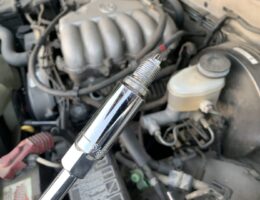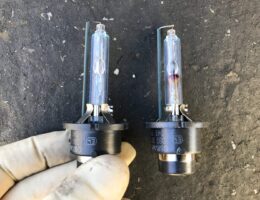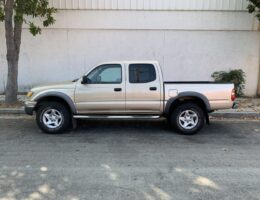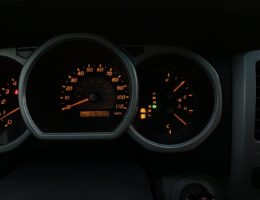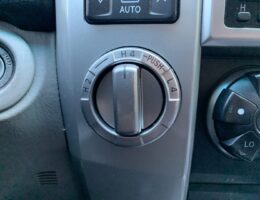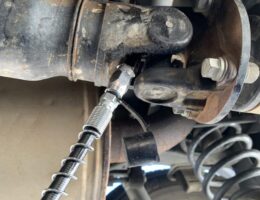The 1st generation Toyota Tacoma with the 3.4L V6 (5VZ-FE engine) has six twin ground electrode spark plugs. Toyota recommends that these spark plugs be replaced every 30,000 miles, however there are many accounts of 5VZ-FE owners who have driven on the same set of spark plugs for double and triple that mileage. I personally wouldn’t let it go to 90,000 miles, but I also wouldn’t necessarily follow the 30k-mile change interval either. My parents’ Tacoma is about 15 years old with only 30k miles on the clock, so we decided to replace the spark plugs more so due to the age rather than the mileage interval.
The 1st generation Toyota Tacoma PreRunner has a RWD drivetrain that uses a rear differential to transfer power from the transmission to the rear wheels. As opposed to a 4WD vehicle which employs the use of a front differential, transfer case, and rear differential to transfer power to all four wheels, a PreRunner with RWD only has a rear differential to service. With regular driving, Toyota suggests inspecting the rear differential fluid every 15,000 miles. My Haynes Manual recommends to replace the differential fluid every 30,000 miles. On my parents’ Tacoma, they don’t do any towing. Their truck sits at a bit over 30k miles so I went ahead and did the first rear differential fluid change on this truck.
Inspection and replacement of the engine air filter on the 1st Gen Toyota Tacoma is probably one of the easiest jobs you’ll encounter. It literally takes 1 minute to inspect and maybe 2 minutes to replace. With that said, there’s no good reason for not following Toyota’s scheduled maintenance interval for inspecting and replacing the engine air filter.
It’s a matter of time before the HID bulb on your 2nd Gen Lexus IS350 goes out. Sometimes the failure can be intermittent with it sometimes working and other times not. It can also fail by simply burning out completely. It’s not difficult to replace the HID bulbs on the 2nd Gen Lexus IS350. You just need to make sure you remove a few things in the engine bay that get in the way when replacing the HID bulbs. Removing some of these parts not only provides you with access to the HID bulbs, but it also gives you room to work.
When my parents bought this 2004 Toyota Tacoma, I didn’t think much of it. Looking back now, I can appreciate that this is one of the better equipped Tacomas of the first generation. It’s the last year of the 1st gen Tacoma(’95-’04), has the 3.4L V6 5VZ-FE engine, and has the PreRunner trim package. Probably the only thing missing that I would want on this truck would be 4WD. If I were to get a midsize pickup truck, I would love to have one of these (believe me, I tried buying it off my parents but they still drive it).
It’s a common issue on the 4th generation Toyota 4Runner to encounter the ‘VSC TRAC’ and ‘VSC OFF’ warning lights come on randomly and stay on. These lights may come on whenever you have an engine trouble code, which will be apparent when the engine light also comes on at the same time. However, if you are experiencing only the ‘VSC TRAC’ and ‘VSC OFF’ lights on without the check engine light on, then there might be a quick fix to getting rid of those lights.
It’s not the question of if your Lexus IS350 remote key will eventually go out, but when. After some time the small coin battery inside of your remote key will eventually go dead and you’ll need to replace it. It usually comes at the most inopportune time, but luckily the IS350 key is easy to take apart even without the use of any tools; all you need is a replacement battery.
If you’re a 4th generation Toyota 4Runner owner, you may have heard of the phrase, “use it or lose it” being used. This term basically means that you should use your four-wheel drive system on a regular basis, otherwise it may stop working later down the road. The electronically-controlled 4WD actuator that is located inside of the transfer case can potentially seize up if not used for prolonged periods of time. Since the actuator is located inside of the transfer case, the transfer case itself needs to be opened before gaining access to the actuator. As you can conclude, if the 4WD actuator fails, you will end up with a costly repair. So “use it or lose it” to save yourself from future headaches.
Lubricating the driveshaft (a.k.a. propeller shaft) is a key maintenance item on the 4th generation Toyota 4Runner that every owner should be doing. Armed with a grease gun and appropriate grease, it is easy to grease up the driveshaft and keep your driveline working properly. There is a bit of variability in information related to how often you should be greasing your driveshaft, as well as what type of grease you should be using on the various components of the propeller shafts. Once you navigate through the confusion around the the maintenance interval and the grease type, the maintenance itself is quite easy and ensures you keep your driveline in tip-top shape.

